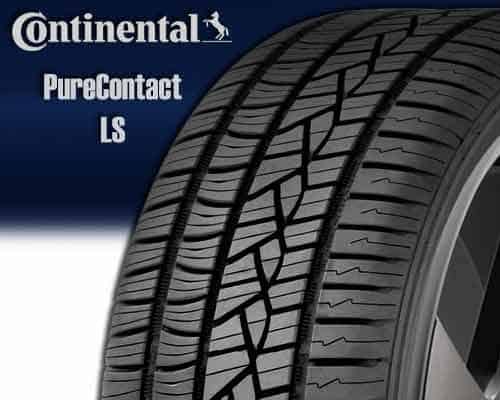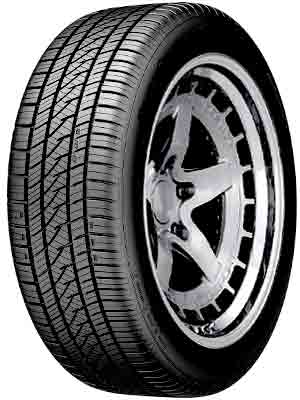Both are premium summer touring tires that are built to provide balanced handling and better grip in dry and wet conditions when the temperature is high.
However, the PureContact features a higher void ratio which is suitable for hydroplaning resistance.

On the other hand, due to the lower void ratio of the TrueContact, this tire becomes capable of securing a good grip on all kinds of surfaces.
To find out how the four-pitch design of both the tires compete against each other in terms of handling, rolling resistance, and comfort, make sure you stick right till the end!
Table of Contents
Quick Comparison

Vs

Featuring an asymmetrical tread design, PureContact consists of two outer shoulders. Three wide grooves are responsible for dividing the tread into four parts.
The outer board shoulders of this tire have lateral grooves which doextend to the boundaries.
Even though sipes are present on the central parts, they are not that effective in performance.
In addition to this, only the outer board shoulders are equipped with the sipes.
Just like the PureContact, the TrueContact also features an asymmetrical four-pitch tread design.
There are two central ribs sandwiched in between the two outer shoulders.
Both the ribs and the shoulders are divided by the three narrow circumferential grooves running around the tread.
The shoulders of this tire are compact and the shoulder blocks are also closely positioned.
However, the lateral grooves are missing from the tread design.
But, this is compensated by the numerous and deep sipes found on both the central part and the shoulder blocks.
Continental PureContact LS

Grip Comparison
When it comes to the grip comparison of both these tires, the PureContact has a lower contact patch and as a result, less surface area of its tread comes in contact with the road. This reduces the tire’s grip, thus, its dry braking distance is increased.
The same is the case for the wet grip,due to inefficient sipes found on the central part and its lower contact patch, this tire underperforms compared to other.
Therefore, its wet braking distance was also recorded higher than its competitor.
TrueContact on the other hand features a higher contact patch which is the reason for good grip on dry roads.
Therefore, its braking distance on dry roads was recorded much lower as compared to its counterpart.
The same performance is translated into the wet grip of this tire as well.
The sipes found on the central part of the tire are deep and numerous.
So, this allows it to stop more quickly on wet roads.
This in turn decreases the wet braking distance of this tire.
Handling Comparison
The PureContact is equipped with relatively smaller shoulder blocks.
As a result, the grip of this tire while steering is decreased and the tire becomes less capable in terms of dry handling.
When it comes to the tire’s performance on wet tracks, there are sipes only on the outboard shoulder.
So, the wet handling of this tire is also less efficient than its counterpart.
Therefore, the time require by the vehicle to complete a lap on both dry and wet circular tracks was recorded much higher.
Conversely, the compact shoulders and the closely packed shoulder blocks of TrueContact make it superior to its competitor.
With the help of compact shoulders, the drivers get improved handling while making turns through sharp edges.
Therefore, this tire completes a lap on a dry circular track in less time.
In addition to this, the presence of numerous and deep sipes on its shoulder blocks enhance the tire’s wet handling capabilities as well.
As a result, the lap time on a wet circular track is also decreased.
Comparison of Hydroplaning Resistance
Talking about the hydroplaning resistance of PureContact, its grooves are wide enough which allows the efficient evacuation of water from its tread.
As a result, this tire achieves a higher floating speed as compared to its counterpart.
This is what makes it a better option to drive on flooded roads.
TrueContact features relatively narrower grooves.
These grooves are not as efficient as PureContact when it comes to wiping away the water.
Therefore, the floating speed of this tire is comparatively lower.
Comparison of Rolling Resistance
The lower contact patch of the PureContact makes the tire’s rolling resistance lower because less amount of friction is produced between the road and its tread.
As a result, the rolling resistance of this tire was recorded lower and since lesser force is required to move this tire, its fuel efficiency was also estimated higher.
On the other hand, due to the higher contact patch of TrueContact, it results in more amount of its tread coming in contact with the road.
This leads to the production of a higher amount of friction and the vehicle must overcome this friction to roll the tire.
This is what contributes to the increased rolling resistance of this tire.
Since too much force is required to roll the tire on the road, therefore, the fuel efficiency of this tire is also lower as compared to that of its peer.
Comfort Comparison
Since the PureContact has a higher void ratio, there is a large space for the air particles to get inside its voids.
When these air particles strike back and forth against the walls of the grooves, a loud noise is produced while driving at high speed.
This decreases the comfort of this tire.
In addition to this, the lower traction performance of the PureContact does not allow it to be subjectively comfortable either.
In comparison, the TrueContact produces less noise because of its lower void ratio.
As a result, this tire allows less space for the entrapment of air particles inside its grooves.
This is what makes this tire a comfortable option in terms of noise.
In terms of subjective comfort, it outperforms its competitor because of its better performance.
Durability & Treadwear
The PureContact features a lower rolling resistance and as a result, its tread wears out slowly. In addition to this, hard rubber is used in the manufacturing of the tread of this tire which adds more to its durability.
This increases the mileage of this tire, making it a much better option than its counterpart.
Comparatively, due to the greater rolling resistance of PureContact, a higher treadwear is caused.
Moreover, a softer rubber is used in the manufacturing of this tire which lowers its durability. So, the lower durability also leads to the higher treadwear.
As a result, PureContact offers lesser number of miles to its users.
Quick Summary
- Both of them are premium summer touring tires.
- The dry and wet grip of the TrueContact is superior.
- The dry and wet handling of the TrueContact is better as well.
- The hydroplaning resistance of the PureContact is more efficient.
- The rolling resistance of the PureContact is lower, leading to higher fuel efficiency.
- The TrueContact offers more comfort to its users.
- The tread of the PureContact wears out slower, leading to higher durability.


